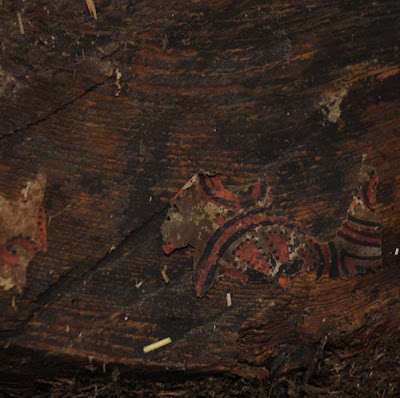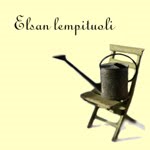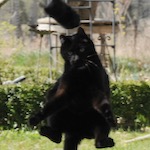 The workmen taking off an in-built bench to be conserved. Smartly, the seat can be drawn out to make two wide beds. The topmost wallpaper layer is a pretty blue-flowered print on off-white background, supposedly from 1930's. The panelling below is painted pale blue and skirting is dark blue. The dado rail is dark stained wood as is the panelled ceiling, very typical for the late 19th century.
The workmen taking off an in-built bench to be conserved. Smartly, the seat can be drawn out to make two wide beds. The topmost wallpaper layer is a pretty blue-flowered print on off-white background, supposedly from 1930's. The panelling below is painted pale blue and skirting is dark blue. The dado rail is dark stained wood as is the panelled ceiling, very typical for the late 19th century.Renovating an old house is rewarding and shattering at the same time. To be able to live in the house, and for the house to be able to live on for another century and more, some interventions are necessary.
On the uphill side, the lowest timber logs need to be replaced. For that, the wooden cladding needed to be taken off and the interior panelling and wallpapering peeled. Only then can one see the condition of the wood.
It feels like vandalism to take off 9 layers of wallpaper, each having been lovingly glued to refresh and renew the house. Lovingly is a supposition, there may have been damp marks and coffee spills.
Three wallpaper layers were found atop the existing panelling. Under that, three more or so. The wallpaper pattern seems to have varied a bit around the room. Under those supposed last layers was a heavier paper that has been wetted and nailed into place, as traditionally was done to prime the wallpapering.
But underneath that, three more traces of age old wallpaper. That raises a question: since from their marks it is obvious the timber logs were brought from another building - they last an age, so naturally all logs were reused as long as they lasted - were these fragments already in the previous building?
We may never know the answer. But one things is certain. Tomorrow I'm off to a bookstore to acquire the just published book on Finnish wallpaper history.
 One of the oldest wallpapers is an ultramarine geometric pattern. Notice the moss that was added between log layers.
One of the oldest wallpapers is an ultramarine geometric pattern. Notice the moss that was added between log layers. This one seems hand-printed: the black is slightly off the red pattern. It is remarkably different from the geometric blue print!
This one seems hand-printed: the black is slightly off the red pattern. It is remarkably different from the geometric blue print!
Tapettilöytöjä
Vanhan talon restaurointi alkoi puuverhouksen purkamisella, vinon verannan poistolla ja sisäpintojen paljastuksella. Nyt pääsee tarkastelemaan hirsien kuntoa.
Tapettikerroksia löytyi yhdeksän - kolme paneloinnin yläpuolelta, kolme, jotka jatkuivat pitkälle paneloinnin alle ja vielä pinkopahvikerroksen alta jäännöksiä kolmesta muinaistapetista. Lienevätköhän tästä talosta vaiko siitä, mistä hirret on tuotu - ne on selvästi siirretty.
Nytpä on asiaa kirjakauppaan heti huomenaamulla. Suomalainen tapettikirja, Suomalaisen kirjallisuuden seuran kustantama, on juuri ilmestynyt!
Vanhan talon restaurointi alkoi puuverhouksen purkamisella, vinon verannan poistolla ja sisäpintojen paljastuksella. Nyt pääsee tarkastelemaan hirsien kuntoa.
Tapettikerroksia löytyi yhdeksän - kolme paneloinnin yläpuolelta, kolme, jotka jatkuivat pitkälle paneloinnin alle ja vielä pinkopahvikerroksen alta jäännöksiä kolmesta muinaistapetista. Lienevätköhän tästä talosta vaiko siitä, mistä hirret on tuotu - ne on selvästi siirretty.
Nytpä on asiaa kirjakauppaan heti huomenaamulla. Suomalainen tapettikirja, Suomalaisen kirjallisuuden seuran kustantama, on juuri ilmestynyt!















.jpg)



























.JPG)



2.JPG)









.JPEG)


.jpg)





.jpg)































































Siellä ollaan päästy tosi toimiin, hienoa! Tuo kerrosten paljastuminen seinissä on varmasti jännää. Onnea restaurointipuuhiin!
ReplyDeleteJuu, ja intoa pukkaa. Kaikki on jännää. Talon perustuksista löytyy vanhaa taottua hellakoukkua, savista kukkopillia ja kankaanmittauskeppiä (entinen emäntä oli ompelijatar). Kun vain ehtisi niin paljon kuin haluaisi. Tehokkuus olisi hieno ominaisuus, vaan se minulta tyystin puuttuu.
ReplyDelete